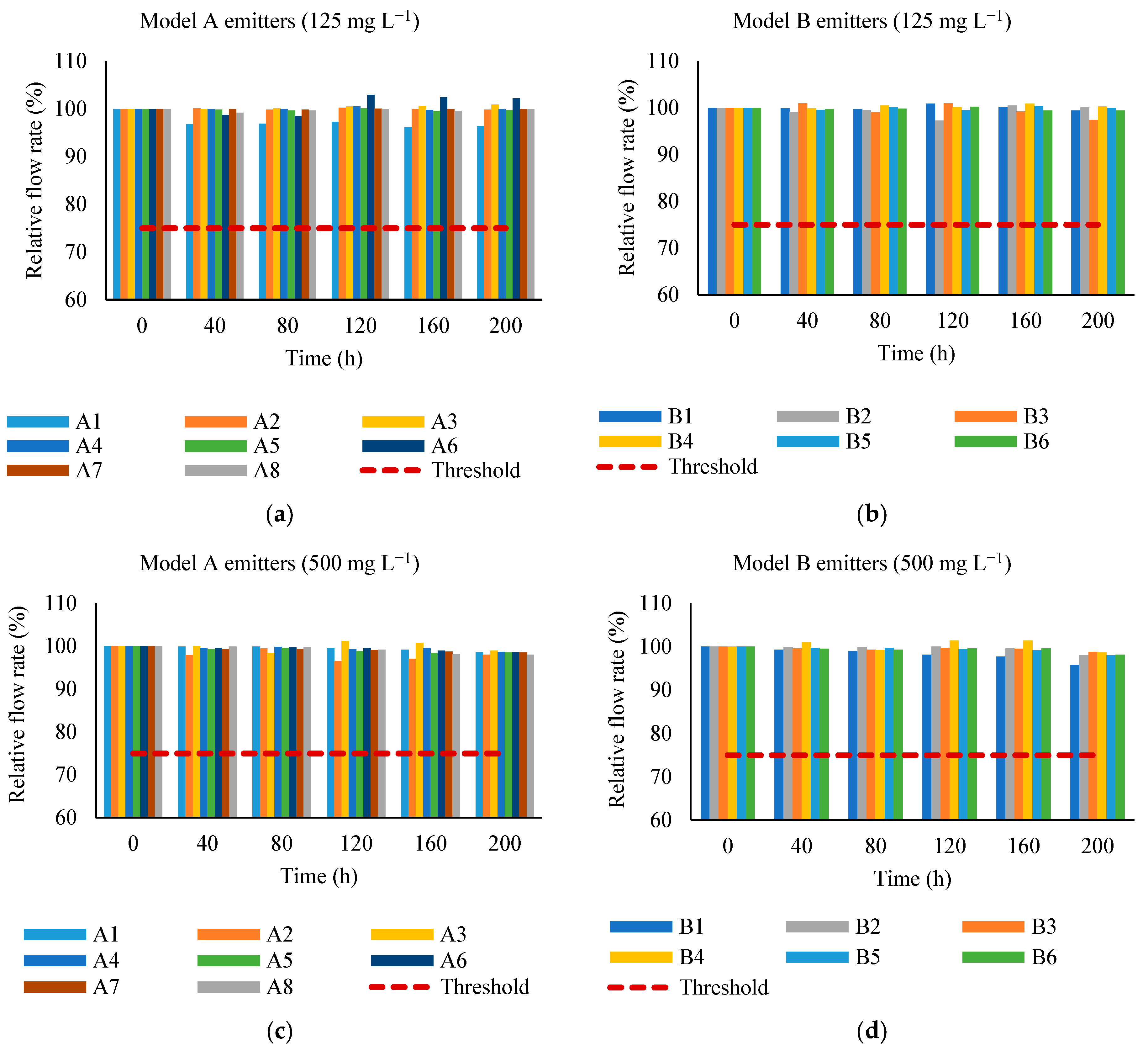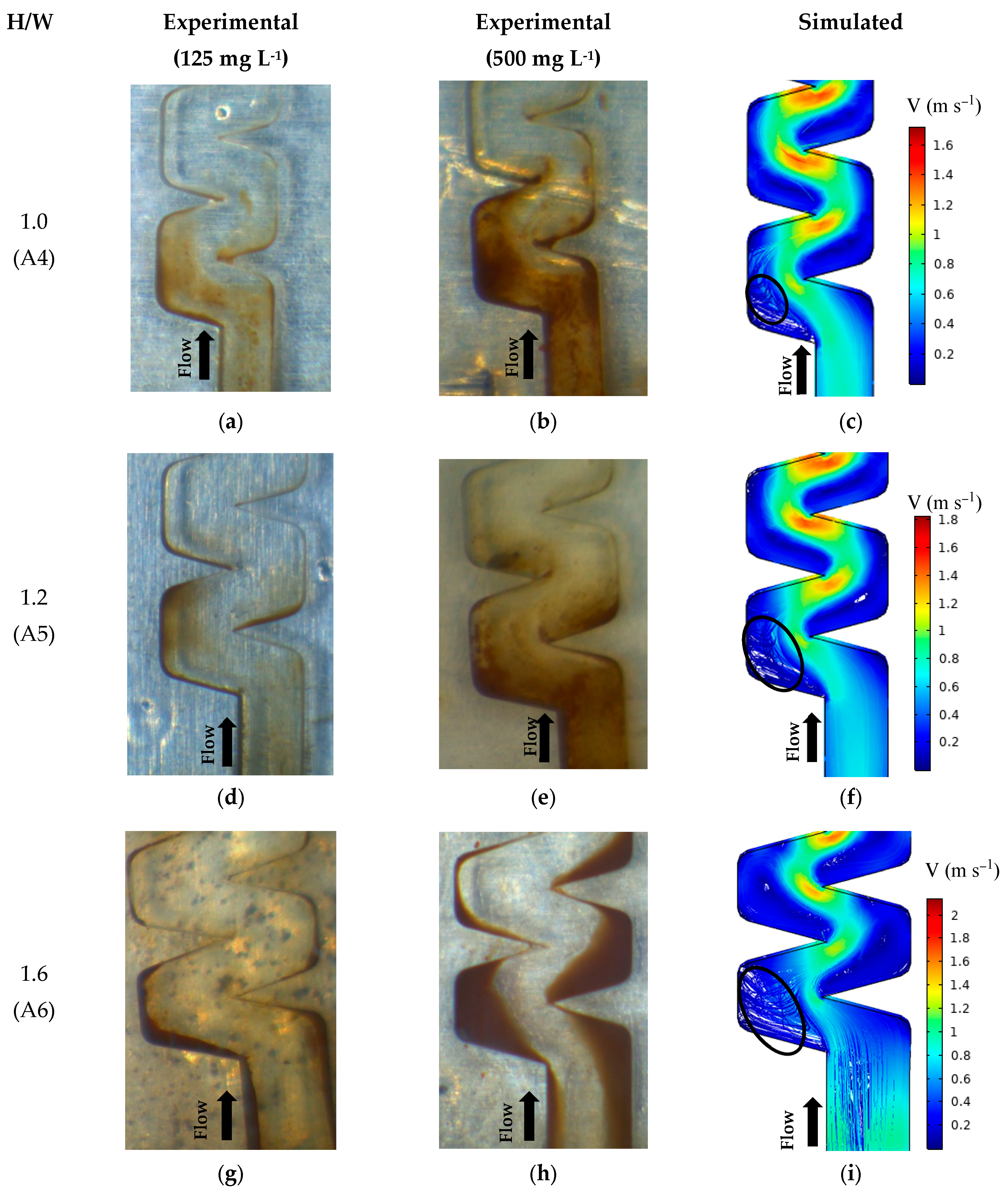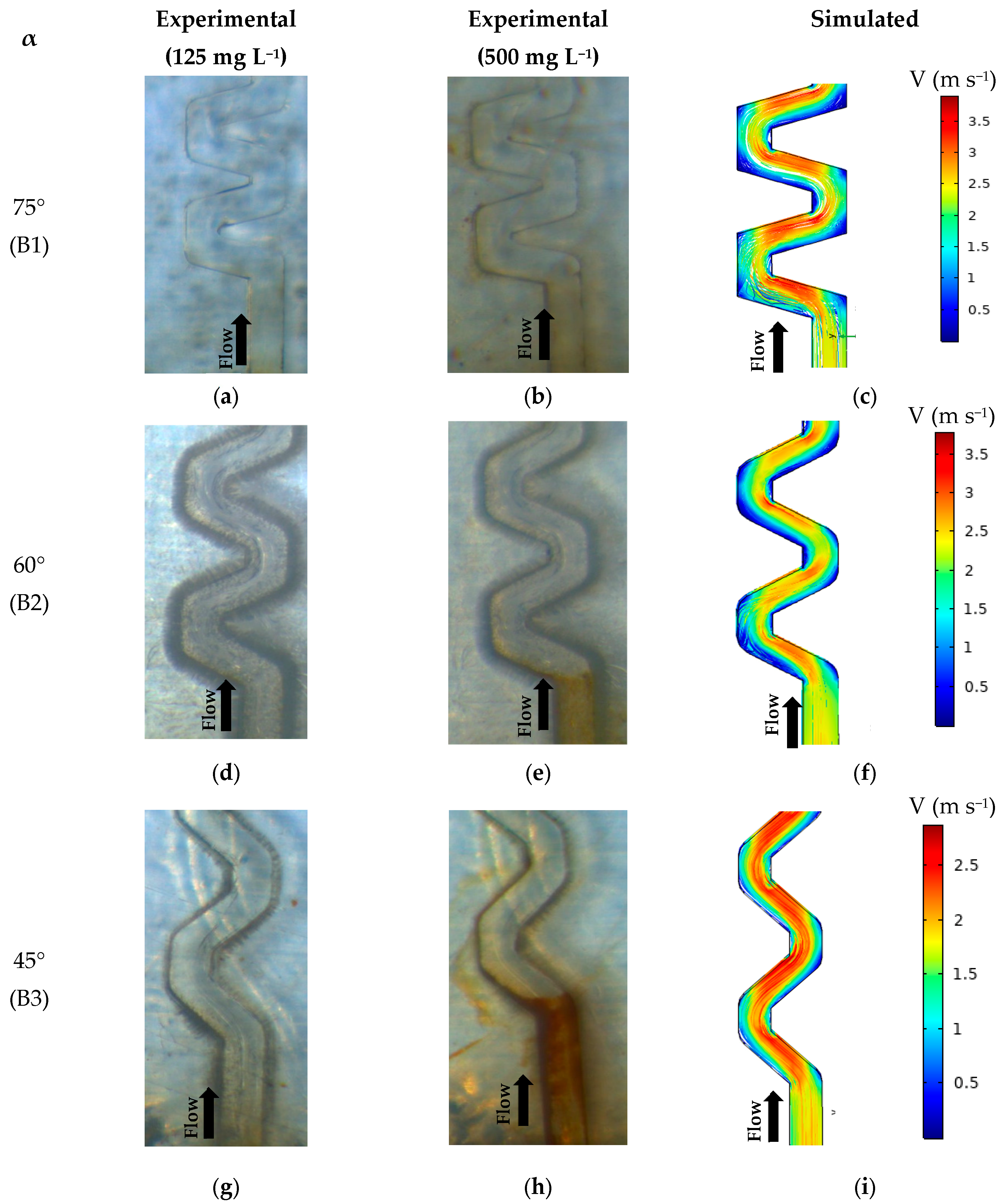Geometric Characteristics of Dripper Labyrinths and Accumulation of Solid Particles: Simulation and Experimentation
Abstract
1. Introduction
2. Materials and Methods
2.1. Labyrinth Prototypes
2.2. Experimental Setup
2.3. Test Conditions
2.4. Dripper Performance Assessment
2.5. CFD Simulations
3. Results and Discussion
3.1. Dripper Performance
3.2. CFD Results and Deposition Patterns
4. Conclusions
Author Contributions
Funding
Data Availability Statement
Conflicts of Interest
Abbreviations
| CFD | Computational Fluid Dynamic |
| EC | Electrical Conductivity |
| NaClO | Sodium Hypochlorite |
| TSS | Total Suspended Solids |
| XRD | X-ray Diffraction |
| ZPC | Zero-point Charge |
References
- Jahangirpour, D.; Zibaei, M. Farmers’ Decision to Adoption of Modern Irrigation Systems Under Risk Condition: Application of Stochastic Efficiency with Respect to a Function Approach. Front. Water 2022, 4, 931694. [Google Scholar] [CrossRef]
- Eekhout, J.P.C.; Delsman, I.; Baartman, J.E.M.; van Eupen, M.; van Haren, C.; Contreras, S.; Martínez-López, J.; de Vente, J. How future changes in irrigation water supply and demand affect water security in a Mediterranean catchment. Agric. Water Manag. 2024, 297, 108818. [Google Scholar] [CrossRef]
- Qi, Z.; Gao, Y.; Sun, C.; Ramos, T.B.; Mu, D.; Xun, Y.; Huang, G.; Xu, X. Assessing water-nitrogen use, crop growth and economic benefits for maize in upper Yellow River basin: Feasibility analysis for border and drip irrigation. Agric. Water Manag. 2024, 295, 108771. [Google Scholar] [CrossRef]
- Ma, C.; Li, M.; Hou, P.; Wang, X.; Sun, Z.; Li, Y.; Xiao, Y.; Li, Y. Biofilm dynamic changes in drip irrigation emitter flow channels using reclaimed water. Agric. Water Manag. 2024, 291, 108624. [Google Scholar] [CrossRef]
- Lv, C.; Niu, W.; Du, Y.; Sun, J.; Dong, A.; Wu, M.; Mu, F.; Zhu, J.; Siddique, K.H.M. A meta-analysis of labyrinth channel emitter clogging characteristics under Yellow River water drip tape irrigation. Agric. Water Manag. 2024, 291, 108634. [Google Scholar] [CrossRef]
- Ma, C.; Jiang, C.; Li, Y.; Shi, N.; Liu, S.; Hu, X.; Liu, Z.; Sun, Z.; Muhammad, T. Effect of lateral flushing on emitter clogging in drip irrigation using high-sediment water. Agric. Water Manag. 2024, 293, 108702. [Google Scholar] [CrossRef]
- Xiao, Y.; Liu, Y.; Ma, C.; Muhammad, T.; Zhou, B.; Zhou, Y.; Song, P.; Li, Y. Using electromagnetic fields to inhibit biofouling and scaling in biogas slurry drip irrigation emitters. J. Hazard. Mater. 2021, 401, 123265. [Google Scholar] [CrossRef]
- Han, S.; Li, Y.; Zhou, B.; Liu, Z.; Feng, J.; Xiao, Y. An in-situ accelerated experimental testing method for drip irrigation emitter clogging with inferior water. Agric. Water Manag. 2019, 212, 136–154. [Google Scholar] [CrossRef]
- Feng, J.; Liu, H.; Liu, Y.; Sun, H.; Ma, C.; Shi, P.; Wang, W.; Xue, S.; Wen, J. Optimal structure selection of emitter flow path in drip irrigation system with inferior water resources. Rev. Bras. Eng. Agrícola Ambient. 2025, 29, e281773. [Google Scholar] [CrossRef]
- Moulia, V.; Heran, M.; Lesage, G.; Hamelin, J.; Pinta, J.; Gazon, A.; Penlae, M.; Bru-Adan, V.; Wéry, N.; Ait-Mouheb, N. Biofilm growth dynamics in a micro-irrigation with reclaimed wastewater in the field scale. J. Environ. Manag. 2024, 370, 122976. [Google Scholar] [CrossRef]
- Paiva, L.A.L.; Batista, R.O.; Silva, R.R.; Moniz, T.D.C.; Augusto, F.I.S.; Cunha, W.A.; Filho, R.A.R.; de Melo, S.B.; Costa, L.R.; de Medeiros, J.F.; et al. Canonical correlation between clogging agents and performance of drippers operating with aquaculture effluents. Rev. Bras. Eng. Agrícola Ambient. 2024, 28, e274127. [Google Scholar] [CrossRef]
- Shen, Y.; Puig-Bargués, J.; Li, M.; Xiao, Y.; Li, Q.; Li, Y. Physical, chemical and biological emitter clogging behaviors in drip irrigation systems using high-sediment loaded water. Agric. Water Manag. 2022, 270, 107738. [Google Scholar] [CrossRef]
- Bounajra, A.; Guemmat, K.E.L.; Mansouri, K.; Akef, F. Towards efficient irrigation management at field scale using new technologies: A systematic literature review. Agric. Water Manag. 2024, 295, 108758. [Google Scholar] [CrossRef]
- Lamm, F.R.; Ayars, J.E.; Nakayama, F.S. Microirrigation for Crop Production: Design, Operation and Management; Elsevier: Amsterdam, The Netherlands, 2006; ISBN 9780444506078. [Google Scholar]
- Bounoua, S.; Tomas, S.; Labille, J.; Molle, B.; Granier, J.; Haldenwang, P.; Izzati, S.N. Understanding physical clogging in drip irrigation: In situ, in-lab and numerical approaches. Irrig. Sci. 2016, 34, 327–342. [Google Scholar] [CrossRef]
- Niu, W.; Liu, L.; Chen, X. Influence of fine particle size and concentration on the clogging of labyrinth emitters. Irrig. Sci. 2013, 31, 545–555. [Google Scholar] [CrossRef]
- Feng, J.; Li, Y.; Liu, Z.; Muhammad, T.; Wu, R. Composite clogging characteristics of emitters in drip irrigation systems. Irrig. Sci. 2019, 37, 105–122. [Google Scholar] [CrossRef]
- Wang, M.; Xue, M.; Sun, H.; Li, H.; Li, R.; Han, Q. Investigating Sedimentation Patterns and Fluid Movement in Drip Irrigation Emitters in the Yellow River Basin. Water 2025, 17, 910. [Google Scholar] [CrossRef]
- Wang, H.; Wang, S.; Wang, W.; Hu, X. Evaluation of the Influence of Labyrinth Channels on Sand Particles from the Perspective of Emitter Clogging. Irrig. Drain. 2025, 74, 1–11. [Google Scholar] [CrossRef]
- He, X.; Wu, P.; Zhang, L.; Wei, Y.; Liu, X.; Yang, F.; Zhou, W. Microporous ceramic emitter: A drip irrigation emitter suitable for high-sediment water. J. Water Process Eng. 2024, 67, 106169. [Google Scholar] [CrossRef]
- Patil, S.S.; Nimbalkar, P.T.; Joshi, A. Hydraulic Study, Design & Analysis of Different Geometries of Drip Irrigation Emitter Labyrinth. Int. J. Eng. Adv. Technol. (IJEAT) 2013, 2, 455–462. [Google Scholar]
- Lavanholi, R.; de Camargo, A.P.; Bombardelli, W.W.Á.; Frizzone, J.A.; Ait-Mouheb, N.; da Silva Eric, A.; de Oliveira, F.C. Prediction of pressure-discharge curves of trapezoidal labyrinth channels from nonlinear regression and artificial neural networks. J. Irrig. Drain. Eng. 2020, 146, 04020018. [Google Scholar] [CrossRef]
- Zhang, J.; Zhao, W.; Tang, Y.; Lu, B. Structural optimization of labyrinth-channel emitters based on hydraulic and anti-clogging performances. Irrig. Sci. 2011, 29, 351–357. [Google Scholar] [CrossRef]
- Zhang, J.; Zhao, W.; Lu, B. Rapid prediction of hydraulic performance for emitters with labyrinth channels. J. Irrig. Drain. Eng. 2013, 139, 414–418. [Google Scholar] [CrossRef]
- Muniz, G.L.; Camargo, A.P.; Signorelli, F.; Bertran, C.A.; Pereira, D.J.S.; Frizzone, J.A. Influence of suspended solid particles on calcium carbonate fouling in dripper labyrinths. Agric. Water Manag. 2022, 273, 107890. [Google Scholar] [CrossRef]
- Nakayama, F.S.; Bucks, D.A. Emitter clogging effects on trickle irrigation uniformity. Trans. ASAE 1981, 24, 77–80. [Google Scholar] [CrossRef]
- Wang, H.; Ling, G.; Hu, M.; Wang, W.; Hu, X. Physical Clogging Characteristics of Labyrinth Emitters under Low-Quality (Sand-Laden Water) Irrigation. Agronomy 2022, 12, 1615. [Google Scholar] [CrossRef]
- Ravina, I.; Paz, E.; Sofer, Z.; Marcu, A.; Shisha, A.; Sagi, G. Control of emitter clogging in drip irrigation with reclaimed wastewater. Irrig. Sci. 1992, 13, 129–139. [Google Scholar] [CrossRef]
- Ribeiro, B.T.; De Lima, J.M.; Curi, N.; De Oliveira, G.C.; Lima, P.L.T. Cargas superficiais da fração argila de solos influenciadas pela vinhaça e fósforo. Química Nova 2011, 34, 5–10. [Google Scholar] [CrossRef]
- APHA. Standard Methods for the Examination of Water and Wastewater, 23rd ed.; American Public Health Association: New York, NY, USA, 2017. [Google Scholar]
- Li, H.; Li, H.; Han, Q.; Huang, X.; Jiang, Y.; Sun, H.; Li, H. Influence of micro/nanobubbles on clogging in drip irrigation systems. RSC Adv. 2020, 10, 38912–38922. [Google Scholar] [CrossRef]
- Yang, J. Computational fluid dynamics studies on the induction period of crude oil fouling in a heat exchanger tube. Int. J. Heat Mass Transf. 2020, 159, 120129. [Google Scholar] [CrossRef]
- Zhou, B.; Xiao, Y.; Han, Z.; Hou, P.; Jia, T.; Zhang, J.; Li, Y. Characterization of emitter clogging substances boundary in subsurface drip irrigation with biogas slurry using porous media model. Agric. Water Manag. 2024, 305, 109133. [Google Scholar] [CrossRef]
- Muniz, G.L.; Benitez, J.S.; de Camargo, A.P.; Lavanholi, R.; Ait-mouheb, N.; Cano, N.D.; Frizzone, J.A. Hydrodynamic flow conditions and calcium carbonate scale in dripper labyrinth with varied geometric configurations. Biosyst. Eng. 2025, 257, 104199. [Google Scholar] [CrossRef]
- Millar, G.J.; Couperthwaite, S.J.; Moodliar, C.D. Strategies for the management and treatment of coal seam gas associated water. Renew. Sustain. Energy Rev. 2016, 57, 669–691. [Google Scholar] [CrossRef]
- Gilbert, R.G.; Nakayama, F.S.; Bucks, D.A.; French, O.F.; Adamson, K.C. Trickle irrigation: Emitter clogging and other flow problems. Agric. Water Manag. 1981, 3, 159–178. [Google Scholar] [CrossRef]
- Coelho, R.D.; de Almeida, A.N.; de Oliveira Costa, J.; de Sousa Pereira, D.J. Mobile drip irrigation (MDI): Clogging of high flow emitters caused by dragging of driplines on the ground and by solid particles in the irrigation water. Agric. Water Manag. 2022, 263, 107454. [Google Scholar] [CrossRef]
- Zhang, L.; Wu, P.; Zhu, D.; Zheng, C. Effect of pulsating pressure on labyrinth emitter clogging. Irrig. Sci. 2017, 35, 267–274. [Google Scholar] [CrossRef]
- Yu, L.; Li, N.; Liu, X.; Yang, Q.; Li, Z.; Long, J. Influence of Dentation Angle of Labyrinth Channel of Drip Emitters on Hydraulic and Anti-Clogging Performance. Irrig. Drain. 2019, 68, 256–267. [Google Scholar] [CrossRef]
- Zhang, J.; Zhao, W.; Wei, Z.; Tang, Y.; Lu, B. Numerical and experimental study on hydraulic performance of emitters with arc labyrinth channels. Comput. Electron. Agric. 2007, 56, 120–129. [Google Scholar] [CrossRef]
- Oliveira, F.C.; Lavanholi, R.; Camargo, A.P.; Frizzone, J.A.; Mouheb, N.A.; Tomas, S.; Molle, B. Influence of Concentration and Type of Clay Particles on Dripper Clogging. Irrig. Drain. Syst. Eng. 2017, 6, 1000184. [Google Scholar] [CrossRef]
- Ait-Mouheb, N.; Schillings, J.; Al-Muhammad, J.; Bendoula, R.; Tomas, S.; Amielh, M.; Anselmet, F. Impact of hydrodynamics on clay particle deposition and biofilm development in a labyrinth-channel dripper. Irrig. Sci. 2019, 37, 1–10. [Google Scholar] [CrossRef]
- United States Department of Agriculture, Natural Resources Conservation Service. National Engineering Handbook, Part 623: Irrigation; USDA NRCS: Washington, DC, USA, 2013.
- Li, G.; Wang, J.; Alam, M.; Zhao, Y. Influence of geometrical parameters of labyrinth flow path of drip emitters on hydraulic and anti-clogging performance. Trans. ASABE 2006, 49, 637–643. [Google Scholar] [CrossRef]
- Zhang, J.; Zhao, W.; Tang, Y.; Lu, B. Anti-clogging performance evaluation and parameterized design of emitters with labyrinth channels. Comput. Electron. Agric. 2010, 74, 59–65. [Google Scholar] [CrossRef]
- Qin, C.; Zhang, J.; Wang, Z.; Lyu, D.; Liu, N.; Xing, S.; Wang, F. Anti-Clogging Performance Optimization for Shunt-Hedging Drip Irrigation Emitters Based on Water–Sand Motion Characteristics. Water 2022, 14, 3901. [Google Scholar] [CrossRef]
- Yang, B.; Wang, J.; Zhang, Y.; Wang, H.; Ma, X.; Mo, Y. Anti-clogging performance optimization for dentiform labyrinth emitters. Irrig. Sci. 2020, 38, 275–285. [Google Scholar] [CrossRef]
- Qingsong, W.; Gang, L.; Jie, L.; Yusheng, S.; Wenchu, D.; Shuhuai, H. Evaluations of emitter clogging in drip irrigation by two-phase flow simulations and laboratory experiments. Comput. Electron. Agric. 2008, 63, 294–303. [Google Scholar] [CrossRef]
- Yu, L.; Li, N.; Yang, Q.; Liu, X. Influence of flushing pressure before irrigation on the anti-clogging performance of labyrinth channel emitters. Irrig. Drain. 2018, 67, 191–198. [Google Scholar] [CrossRef]










| Model | Prototypes | W (mm) | D (mm) | A (mm2) | H (mm) | α (°) | (-) | N (-) | L (mm) |
|---|---|---|---|---|---|---|---|---|---|
| A | 1 | 0.7 | 0.8 | 0.49 | 0.70 | 75 | 17.71 | 23 | 33.33 |
| 2 | 0.7 | 0.8 | 0.49 | 0.84 | 75 | 21.21 | 19 | 27.54 | |
| 3 | 0.7 | 0.8 | 0.49 | 1.12 | 75 | 25.32 | 16 | 23.19 | |
| 4 | 1.0 | 0.8 | 1.00 | 1.00 | 75 | 18.82 | 44 | 91.10 | |
| 5 | 1.0 | 0.8 | 1.00 | 1.20 | 75 | 24.58 | 34 | 70.40 | |
| 6 | 1.0 | 0.8 | 1.00 | 1.60 | 75 | 30.09 | 28 | 58.00 | |
| 7 | 1.3 | 0.8 | 1.69 | 1.30 | 75 | 20.97 | 67 | 177.65 | |
| 8 | 1.3 | 0.8 | 1.69 | 1.56 | 75 | 28.84 | 49 | 131.89 | |
| 9 | 1.3 | 0.8 | 1.69 | 2.08 | 75 | 31.84 | 45 | 118.43 | |
| B | 1 | 0.5 | 0.5 | 0.25 | 0.71 | 45 | 2.23 | 37 | 89.32 |
| 2 | 0.5 | 0.5 | 0.25 | 0.87 | 60 | 4.42 | 18 | 36.00 | |
| 3 | 0.5 | 0.5 | 0.25 | 0.71 | 75 | 8.04 | 10 | 15.18 | |
| 4 | 0.8 | 0.8 | 0.64 | 1.13 | 45 | 2.31 | 230 | 888.42 | |
| 5 | 0.8 | 0.8 | 0.64 | 1.39 | 60 | 3.99 | 133 | 425.60 | |
| 6 | 0.8 | 0.8 | 0.64 | 1.55 | 75 | 7.28 | 73 | 177.26 |
Disclaimer/Publisher’s Note: The statements, opinions and data contained in all publications are solely those of the individual author(s) and contributor(s) and not of MDPI and/or the editor(s). MDPI and/or the editor(s) disclaim responsibility for any injury to people or property resulting from any ideas, methods, instructions or products referred to in the content. |
© 2025 by the authors. Licensee MDPI, Basel, Switzerland. This article is an open access article distributed under the terms and conditions of the Creative Commons Attribution (CC BY) license (https://creativecommons.org/licenses/by/4.0/).
Share and Cite
Muniz, G.L.; de Camargo, A.P.; Ait-Mouheb, N.; Cano, N.D. Geometric Characteristics of Dripper Labyrinths and Accumulation of Solid Particles: Simulation and Experimentation. AgriEngineering 2025, 7, 217. https://doi.org/10.3390/agriengineering7070217
Muniz GL, de Camargo AP, Ait-Mouheb N, Cano ND. Geometric Characteristics of Dripper Labyrinths and Accumulation of Solid Particles: Simulation and Experimentation. AgriEngineering. 2025; 7(7):217. https://doi.org/10.3390/agriengineering7070217
Chicago/Turabian StyleMuniz, Gustavo Lopes, Antonio Pires de Camargo, Nassim Ait-Mouheb, and Nicolás Duarte Cano. 2025. "Geometric Characteristics of Dripper Labyrinths and Accumulation of Solid Particles: Simulation and Experimentation" AgriEngineering 7, no. 7: 217. https://doi.org/10.3390/agriengineering7070217
APA StyleMuniz, G. L., de Camargo, A. P., Ait-Mouheb, N., & Cano, N. D. (2025). Geometric Characteristics of Dripper Labyrinths and Accumulation of Solid Particles: Simulation and Experimentation. AgriEngineering, 7(7), 217. https://doi.org/10.3390/agriengineering7070217







